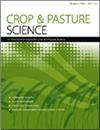Defoliation management and nitrogen fertiliser rate affect canopy structural traits of grazed guineagrass (Megathyrsus maximus) cv. Zuri under rotational stocking
IF 1.9
4区 农林科学
Q2 AGRICULTURE, MULTIDISCIPLINARY
引用次数: 0
Abstract
ABSTRACT Context. Defoliation management by grazing or clipping, combined with nitrogen (N) fertilisation, can increase forage production in tropical grasses. Use of pasture canopy height as a practical tool for monitoring forage mass and accumulation has been proposed because of the relationship between height and canopy light interception. However, this relationship can vary due to variations in canopy structural changes and N supply. Aims. Our objectives were to study canopy structural responses and forage accumulation of grazed Zuri guineagrass (Megathyrsus maximus) under rotational stocking. Methods. Combinations of two pre-graze canopy heights (55 and 75 cm) and two N fertilisation rates (150 and 300 kg N ha−1 year−1) were used during two consecutive years. Cattle grazed the pastures to 50% of pre-graze height. Key results. Regardless of N rate, pastures managed at 75 cm always reached 95% light interception at pre-graze. The 55 cm/300 kg N pastures underwent structural changes such as greater leaf proportion, tiller population density and specific leaf area, and smaller mean foliage angle, which resulted in 95% light interception at pre-graze. Forage accumulation was 20% greater for 75 cm pastures (22 120 kg DM ha−1 year−1) than 55 cm pastures. Pastures receiving 300 kg N ha−1 year−1 had 38% greater forage accumulation than those receiving 150 kg N ha−1 year−1. Conclusion. Zuri guineagrass pastures should be defoliated when canopy height reaches 75 cm owing to greater forage accumulation, but can be grazed at 55 cm when N is applied at 300 kg ha−1 year−1. Implications. Zuri guineagrass can be managed with shorter pre-graze canopy height; when grazed at 55 cm and with 300 kg N ha−1 year−1, there is no negative effect on forage accumulation, allowing for shorter rest periods.落叶管理和氮肥施用量对放牧豚草冠层结构性状的影响。Zuri轮放养
本文章由计算机程序翻译,如有差异,请以英文原文为准。
求助全文
约1分钟内获得全文
求助全文
来源期刊

Crop & Pasture Science
AGRICULTURE, MULTIDISCIPLINARY-
CiteScore
4.20
自引率
15.80%
发文量
111
审稿时长
3 months
期刊介绍:
Crop and Pasture Science (formerly known as Australian Journal of Agricultural Research) is an international journal publishing outcomes of strategic research in crop and pasture sciences and the sustainability of farming systems. The primary focus is broad-scale cereals, grain legumes, oilseeds and pastures. Articles are encouraged that advance understanding in plant-based agricultural systems through the use of well-defined and original aims designed to test a hypothesis, innovative and rigorous experimental design, and strong interpretation. The journal embraces experimental approaches from molecular level to whole systems, and the research must present novel findings and progress the science of agriculture.
Crop and Pasture Science is read by agricultural scientists and plant biologists, industry, administrators, policy-makers, and others with an interest in the challenges and opportunities facing world agricultural production.
Crop and Pasture Science is published with the endorsement of the Commonwealth Scientific and Industrial Research Organisation (CSIRO) and the Australian Academy of Science.
 求助内容:
求助内容: 应助结果提醒方式:
应助结果提醒方式:


